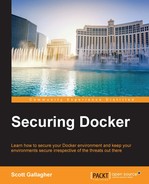Book Description
Learn how to secure your Docker environment and keep your environments secure irrespective of the threats out there
About This Book
- Gain confidence in using Docker for containerization without compromising on security
- This book covers different techniques to help you develop your container security skills
- It is loaded with practical examples and real-world scenarios to secure your container-based applications
Who This Book Is For
This book is for developers who wish to use Docker as their testing platform as well as security professionals who are interested in securing Docker containers. You must be familiar with the basics of Docker.
What You Will Learn
- Find out how to secure your Docker hosts and nodes
- Secure your Docker components
- Explore different security measures/methods for Linux kernels
- Install and run the Docker Bench security application
- Monitor and report security issues
- Familiarize yourself with third-party tools such as Traffic Authorization, Summon, sVirt, and SELinux to secure your Docker environment
In Detail
With the rising integration and adoption of Docker containers, there is a growing need to ensure their security.
The purpose of this book is to provide techniques and enhance your skills to secure Docker containers easily and efficiently. The book starts by sharing the techniques to configure Docker components securely and explore the different security measures/methods one can use to secure the kernel.
Furthermore, we will cover the best practices to report Docker security findings and will show you how you can safely report any security findings you come across. Toward the end, we list the internal and third-party tools that can help you immunize your Docker environment.
By the end of this book, you will have a complete understanding of Docker security so you are able to protect your container-based applications.
Style and approach
This book is your one-stop solution to resolve all your Docker security concerns. It will familiarize you with techniques to safeguard your applications that run on Docker containers.
